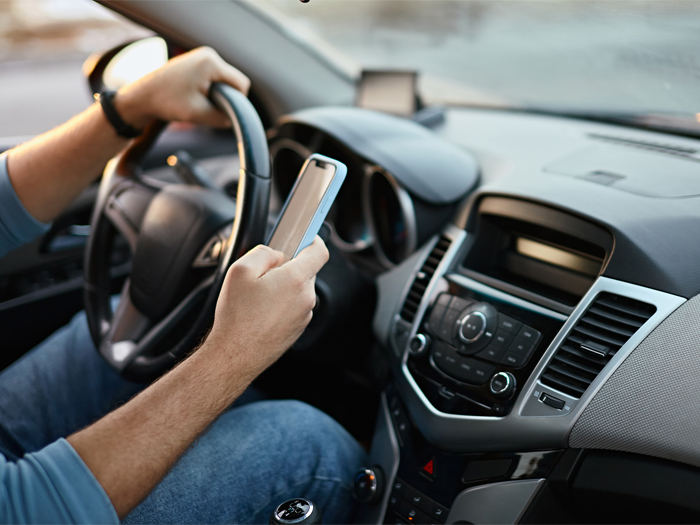Understanding Distracted Driving: 5 Questions for Arity’s Henry Kowal

Some insurance trends are hard to identify. Rising auto insurance premiums is not one of them: All 10 of the largest auto underwriters raised their premiums by double digits in 2023, per S&P Global Market Intelligence. According to Bankrate, this translated into a 26% year-over-year increase in the average cost of a full-coverage car insurance policy.
There are a few possible reasons for this — the rising cost to repair or replace damaged vehicles, for instance, or the increase in nuclear verdicts — but the simplest explanation is that drivers are simply getting into more accidents.
During the work-from-home boom of 2020, the number of auto accidents per mile dropped, but the number of auto accident fatalities went up, even measured in real terms. Over the following year, 2021, auto fatalities didn’t just rise to pre-pandemic levels — they reached the worst levels we’ve seen since 2005, a jump that represents the largest year-over-year increase in almost half a century, according to recent figures from the National Highway Traffic Safety Administration (NHTSA).
The same report identified a 12% year-over-year increase in fatal crashes involving at least one distracted driver.
Our pre-pandemic benchmarks were nothing to boast about, either: In 2019, according to NHTSA data, distracted driving — defined as handling a phone or taking calls while driving — was a factor in thousands of accidents, claiming untold lives and inflicting $98 billion in damage.
Things have only gotten worse since then. In a study released last year by Arity, a mobility data and analytics company founded by Allstate in 2016, data showed a 30% increase in distracted driving between 2019 and 2023. In fact, the rise of distracted driving mirrors the rise of smartphones quite closely, and anecdotal evidence suggests that collisions with stationary objects now make up a larger proportion of accidents. It’s not hard to connect the dots.
Unsurprisingly, Arity’s latest study on distracted driving, released April 1, shows that distracted driving has risen yet again in 2024. Writing about distracted driving in Fast Company, Arity president Gary Hallgren said that “our transportation system is broken, and it’s incurring a significant human cost … By using the vast amount of data available to us, we can better understand the shape and nature of problems, identify effective solutions, and build on progress over time.”
Risk & Insurance® spoke with Henry Kowal, director, outbound product management, insurance solutions at Arity, to gain more insight into what’s influencing the surge in distracted driving and how we can tackle the problem. This interview has been edited for length and clarity.
Risk & Insurance: How does Arity collect data on driver behavior? What kinds of data do you capture and what insights are extracted?

Henry Kowal, director, outbound product management, insurance solutions, Arity
Henry Kowal: As a mobility and data analytics company focused on improving transportation, Arity collects and analyzes an enormous amount of data. And what I mean by enormous is that we’ve collected over 1.6 trillion miles of driving data since our inception in 2016.
On a daily basis, we collect approximately 1 billion miles’ worth of data. By combining this data with predictive analytics, we build solutions aimed at making transportation smarter, safer and more useful for everyone.
Our driving data covers the entire United States, down to the county and ZIP code level. About 65% of our data comes from arterial roadways, which include not only highways but also suburban and rural roads. So we have a strong pulse on what is happening on roadways across the U.S. in terms of both driving activity and behavior.
We collect this driving data from various sources with user consent, including mobile consumer apps like Life360 and GasBuddy, insurance telematics programs like Allstate’s Drivewise or Texas Farm Bureau’s Drive’n Save, and connected vehicles from top automakers.
From the collected data, we can determine specific driver behaviors such as hard braking frequency, speeding, rapid acceleration and distracted driving. We can also understand the contextual elements of driving, including the types of roadways traveled — highway, rural or suburban — the driver’s speed relative to the posted speed limit, and whether they are navigating through busy intersections.
Furthermore, our analysis enables us to examine driving events in combination. For example, our data shows that if a driver is talking on their phone while driving and immediately follows that with a hard braking event, the potential insurance cost of such an incident is typically 60% higher due to the relationship between distracted driving and risky behavior.
R&I: What trends have you observed in the auto space the past decade?
HK: The number of vehicle-related fatalities has risen 30% over the past decade. And even though the number decreased 0.3% in 2022, it still remains higher than what we observed in the early 2010s — which a cause for concern. As vehicle safety technology continues to advance, one would expect to see a more pronounced downward trend. The lack of such a trend suggests that there are other factors at play, such as distracted driving or increased miles driven, which may be offsetting the benefits of improved vehicle safety features.
At Arity, we closely monitored driving behavior during the pandemic. Initially, in April and May 2020, we saw a massive decline in miles driven as people sheltered at home and worked remotely. However, during this time, speeding increased, quite often to rates higher than 80 miles per hour.
But as COVID restrictions eased and people began to venture out more, we noticed that although the total miles driven were still lower than pre-pandemic levels, the frequency of high-risk behaviors, such as speeding and hard braking, had increased. This trend suggests that while fewer people were driving, those who were on the roads were engaging in riskier behaviors.
As we move further away from the height of the pandemic, driving patterns continue to evolve. While miles driven are gradually returning to pre-pandemic levels, the heightened frequency of risky driving behaviors persists.
Our data shows that distracted driving increased more than 30% from 2019 to 2024. According to the latest data released by the NHTSA on April 1st, there were approximately 3,000 fatalities in 2022 where distracted driving was a leading factor. The report also showed an increase in the number of pedestrian and cyclist fatalities and estimated that around 600 of these fatalities were related to distracted driving. Additionally, an estimated 289,000 people were injured in distracted driving-related crashes.
R&I: Is there a connection between drivers being forced to slow down, such as in heavy traffic or bad weather conditions, and an increase in distracted driving?
HK: Yes, our data shows that when drivers are forced to slow down, they are more likely to engage in distracted driving behaviors, particularly phone use.
It’s a concerning trend, because even at low speeds, distracted driving poses significant risks. Slowed traffic often involves stop-and-go movement and requires drivers to remain alert. But our data indicates that during slow-moving traffic and congested commutes, people are more inclined to reach for their phones and use them while driving.
Conversely, on days like Sunday, when there is typically less traffic and congestion on the roads, people tend to drive at higher speeds and engage in more highway driving. In these circumstances, there is less phone distraction observed.
R&I: Surveys show that many drivers admit to engaging in behaviors they know are risky. What explains the disconnect between drivers acknowledging the risk of behaviors like hard braking and speeding but still engaging in them?
HK: It’s a fascinating disconnect, isn’t it? People clearly understand that certain behaviors behind the wheel are risky, but many still choose to engage in them. This highlights the complex psychology of driving.
Cognitive dissonance plays a significant role here. Drivers may rationalize their unsafe behaviors, thinking “I can handle it,” or “It won’t happen to me.” This mindset allows them to maintain their self-image as capable drivers while engaging in behaviors they know to be dangerous.
Additionally, the sense of control and anonymity that comes with driving can lead to overconfidence and a feeling of invincibility. The immediate gratification of arriving at a destination faster or the thrill of speeding can override the intellectual understanding of the risks involved.
Some research also suggests a concept called compensatory belief, where individuals believe they can mitigate risky behavior with other safe behaviors — for example, that driving slower can minimize the impact and risk of distracted driving.
In heavy traffic, people might assume that driving slower, having others around them moving slowly, and staying in a single lane reduces the impact of distracted driving. This might help explain the disconnect between understanding the risk and still engaging in the behavior.
One way to address this is through education campaigns that debunk myths, emphasizing that there are still risks to distracted driving even at low speeds or in bumper-to-bumper traffic. Another approach is through awareness and technology, such as insurance telematics programs like our smartphone app, Routely.
Routely measures a user’s driving and provides feedback on their habits, including speeding, hard braking and phone use. Individuals who participate typically improve their driving behavior: Within 30 days, about 20% of distracted drivers see an improvement of about half in their behavior, and the best participants see a 70% improvement.
The app also incorporates gamification, tracking how many trips a user can drive distraction-free and resetting the count when they drive distracted. That internal self-gamification effect helps improve behavior.
While these methods can help curb distraction, there is still a long way to go, and more needs to be done to address this issue effectively.
R&I: How can auto insurance companies use telematics programs to incentivize safer driving behaviors and potentially reduce insurance rates for individuals?
HK: For those who are not yet safe drivers, telematics programs can serve as a motivator for improvement. By enrolling in the program, drivers can receive personalized coaching based on their specific driving behaviors. This feedback empowers them to enhance their driving performance, potentially earning them a discount or a better rate at their next auto insurance renewal.
Ultimately, tying driving behavior to auto insurance rates through telematics programs can be an effective way to encourage safer driving habits. It leverages the financial impact on an individual’s pocketbook as an incentive for positive change.
Telematics programs can also benefit the insurance company, which aims to have as many safe drivers as possible in their book of business. By analyzing driving behavior, insurers can more accurately assess risk and price policies accordingly. This data-driven approach lets insurers offer personalized premiums based on individual driving habits, rewarding safe drivers with lower rates.
Telematics data can also help insurers identify and mitigate fraudulent claims. By reconstructing accident scenarios using telematics data, insurers can validate the authenticity of claims and reduce costs associated with fraudulent activities.
By leveraging telematics data, insurers can not only offer more accurate pricing but also incentivize safer driving behaviors, ultimately leading to fewer accidents and lower claims costs. &











